As you journey into the domain of Nordic Skaldic poetry, you'll uncover a rich tapestry of myth, heroism, and Norse sagas. Emerging in the 9th century, this traditional form of Old Norse poetry weaves cosmic symbolism, mythological themes, and legendary heroes into a spellbinding narrative. Skalds, medieval poets, crafted complex, emotionally charged verses that resonate with archetypal significance. You'll find that mythological motifs symbolize human struggles and conditions, while legendary heroes like Sigurd and Ragnar embody Norse societal values. As you explore further, you'll unravel the intricate threads of metaphors, imagery, and poetic devices that continue to inspire modern artists and enthrall audiences across the ages.
Origins of Skaldic Poetry

Exploring the rich cultural heritage of the Nordic people, you'll discover that Skaldic poetry, a traditional form of Old Norse poetry, has its roots in the Viking Age, emerging circa 9th century in Scandinavia. As you investigate further, you'll find that Skaldic poetry was deeply intertwined with Viking chronicles, which documented the exploits of Norse warriors and their mythological gods. These chronicles often featured mythological tales of gods and goddesses, reflecting the Pagan rituals and beliefs of the time.
In this era, Skaldic poetry was primarily an oral tradition, passed down through generations by traveling bards. These poets, known as skalds, would recite their works in courts and mead halls, regaling audiences with tales of heroic deeds and mythological events. The poetry itself was characterized by its use of complex metaphors, kennings, and allusions to Norse mythology. By examining these ancient poems, you'll gain insight into the values and beliefs of the Viking people, as well as their rich cultural heritage.
The Skalds: Medieval Poetic Masters
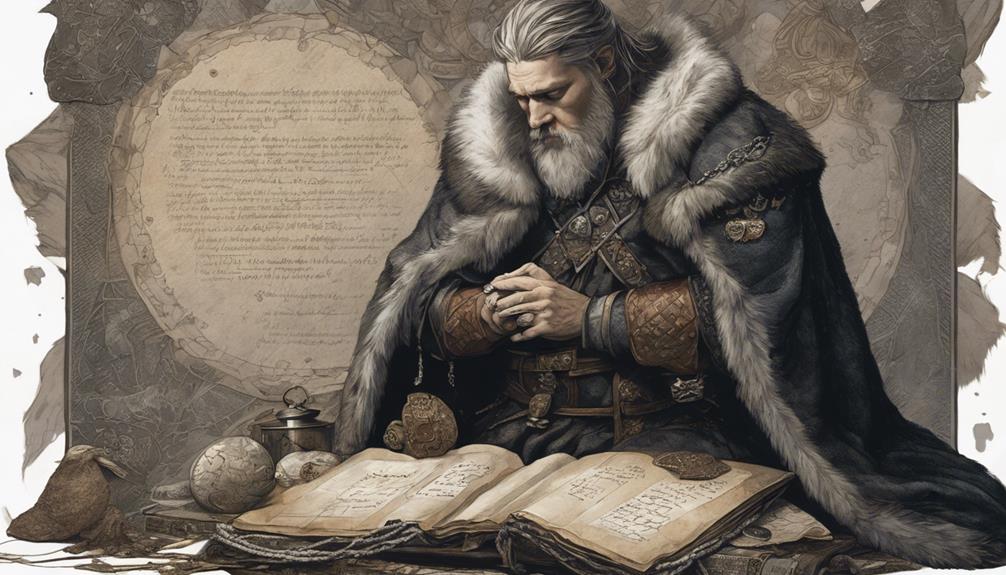
As you explore the world of Skaldic poetry, you'll encounter the masters behind the medieval masterpieces: the skalds, a select group of poets who wielded their words like craftsmen, shaping the Norse cultural identity with each carefully constructed verse. These poetic masters thrived in the courts of Scandinavian kings and chieftains, where they enjoyed courtly patronage and competed with one another in poetic rivalries. The skalds' artistry was highly valued, and their poems served as a means of conveying praise, satire, or even propaganda. In this environment, poets honed their skills, often engaging in verbal sparring matches, where they'd exchange clever insults or boasts. This competitive atmosphere fueled their creativity, driving them to innovate and perfect their craft. As a result, the skalds produced works that continue to captivate audiences with their richness, complexity, and emotional depth.
Mythological Themes and Motifs
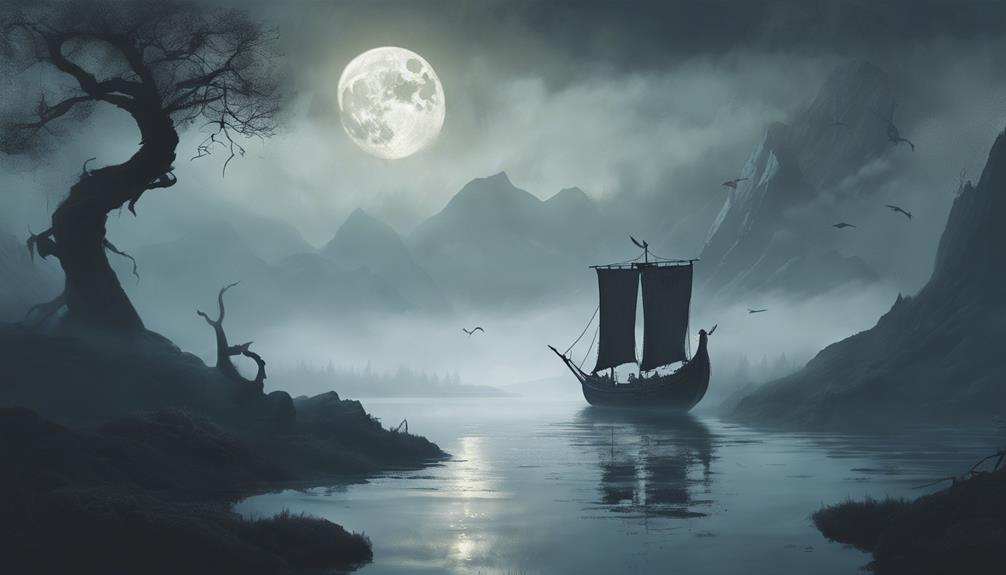
When exploring the domain of Skaldic poetry, you'll uncover that mythological themes and motifs are intricately woven into the tapestry of these medieval masterpieces, often drawing upon the rich tapestry of Norse mythology to convey complex ideas and emotions. The poetry is replete with cosmic symbolism, where the struggles of gods and giants serve as metaphors for the human experience. The Skalds employ these mythological themes to convey the tumultuous nature of existence, where the boundaries between the mortal and divine domains are blurred.
As you investigate further into the poetry, you'll discover that the mythological motifs resonate with archetypal significance, tapping into the collective unconscious of the human psyche. The struggles of the gods and goddesses of the Norse pantheon – Odin, Thor, Freyja, and others – serve as powerful archetypes, symbolizing the eternal human struggles with fate, morality, and the human condition. Through their masterful use of mythological themes and motifs, the Skalds created a rich cultural heritage that continues to captivate and inspire audiences to this day.
Legendary Heroes of Norse Sagas

Among the most revered figures in Norse sagas, legendary heroes like Sigurd the Volsung, Ragnar Lothbrok, and Starkad emerge as exemplars of courage, cunning, and conviction, their legendary exploits enthralling audiences for centuries. You'll find that these famous Vikings have become synonymous with Heroic Deeds, their bravery and prowess in battle captivating the imagination of people across the ages. As you explore the sagas, you'll discover that these heroes embody the values of Norse society, upholding honor, loyalty, and strength in the face of adversity. Their stories, passed down through generations, have inspired countless adaptations in literature, art, and popular culture. From Sigurd's slaying of the dragon Fafnir to Ragnar's daring raids, their exploits have become an integral part of the Norse cultural heritage. As you investigate the world of Norse sagas, you'll find that these legendary heroes continue to fascinate and inspire, their heroic deeds a tribute to the enduring power of myth and legend.
The Power of Metaphor and Imagery
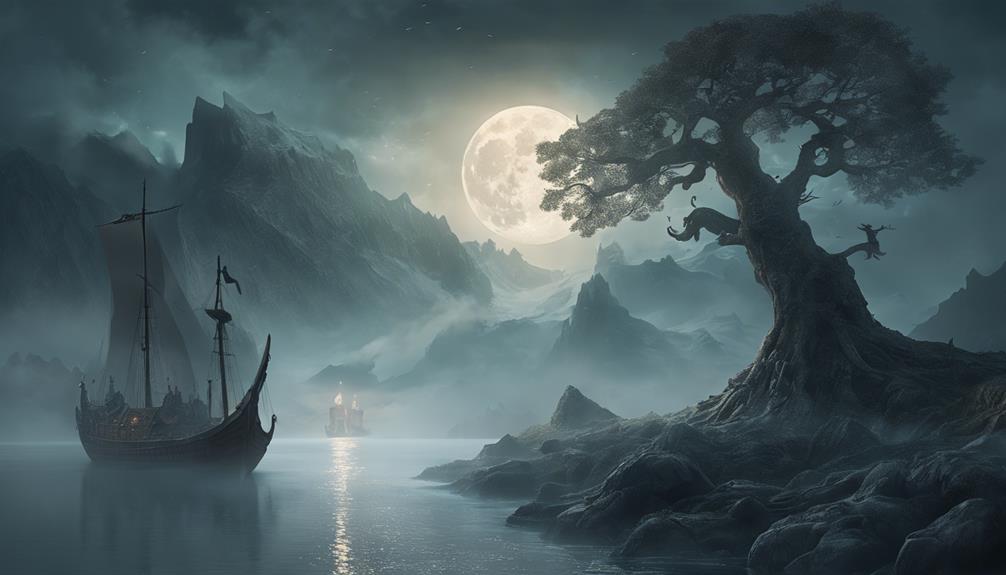
In the rich tapestry of Nordic Skaldic poetry, you'll find that metaphors and imagery serve as potent tools, uncovering the mythic landscapes and heroic deeds that define the Norse sagas. Through vivid descriptions, poets transport you to sensory landscapes where the sounds of clashing swords and the scent of burning villages envelop you. The imagery is deliberate, crafted to evoke an emotional response and establish a connection to the mythic world. Metaphors, in particular, hold symbolic resonance, as they convey the complexities of human experience through the lens of mythological archetypes. For instance, the wolf, symbolizing chaos and destruction, serves as a powerful metaphor for the destructive forces that threaten the social order. By tapping into these symbolic associations, poets create a rich tapestry of meaning that invites you to explore the deeper themes and motifs woven throughout the Norse sagas. As you immerse yourself in the world of Nordic Skaldic poetry, you'll discover how metaphors and imagery work in tandem to craft a compelling narrative that continues to captivate audiences to this day.
Language and Poetic Devices
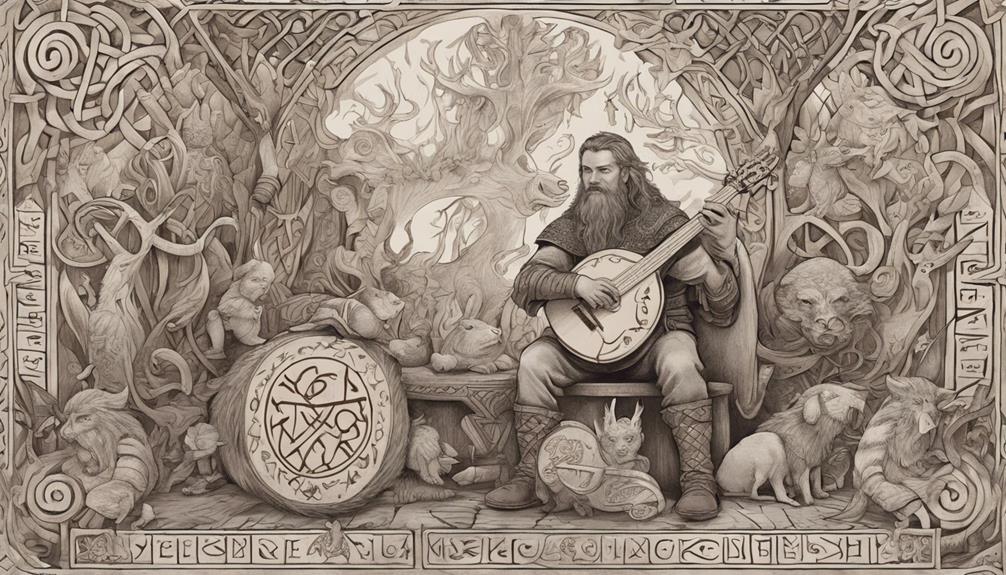
As you explore further into the domain of Nordic Skaldic poetry, you'll discover that the masters of this ancient art form wielded language and poetic devices with remarkable precision, crafting a unique sonic landscape that resonates with the mythic and heroic themes explored up to this point.
The skalds' command of language allowed them to weave intricate patterns of sound and sense, drawing listeners into a world of myth and legend. Rhythm syntax, for instance, was carefully calibrated to create a sense of momentum, propelling the narrative forward with a dynamic energy. Alliterative patterns, too, were deployed with precision, conjuring a sonic tapestry of repeating consonants and vowels that echoed the rhythms of the natural world.
Through their mastery of language and poetic devices, the skalds created a distinctive voice that was at once both personal and communal, speaking to the experiences and aspirations of their audience. By examining the intricate web of sounds, rhythms, and imagery woven into these poems, you'll gain a deeper appreciation for the artistry and craftsmanship that underpins this ancient literary tradition.
Norse Gods and Goddesses in Verse
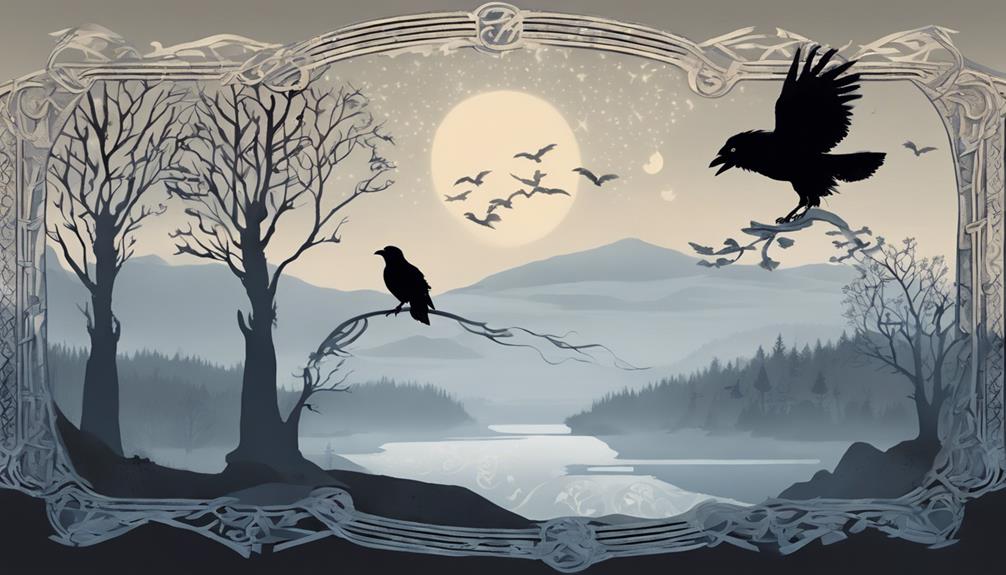
Two dozen Norse gods and goddesses, each with their distinct personalities and mythological roles, populate the poetic landscape of Nordic Skaldic verse, awaiting your exploration. As you explore the world of Skaldic poetry, you'll encounter a pantheon of deities who influenced the lives of medieval Scandinavians. These divine figures are not mere mythological relics but active participants in the poetic narrative, often invoked to bestow divine patronage upon the poet's patrons or to validate the ruling elite.
Poetic invocations of the gods are woven throughout Skaldic verse, where the poet's art is often presented as a gift from the gods. Odin, the All-Father, is frequently invoked as the patron deity of poetry, while Thor's mighty hammer, Mjolnir, serves as a symbol of divine protection. The goddess Freyja, associated with love, fertility, and war, is also a popular figure in Skaldic poetry, often invoked to secure the poet's patron's military victories. As you explore the world of Nordic Skaldic poetry, you'll find that the gods and goddesses are not just passive characters but active agents, shaping the poetic narrative and imbuing it with mythological significance.
Legacy of Skaldic Poetry Today

You'll find that the rich literary heritage of Nordic Skaldic poetry continues to inspire modern artists, writers, and musicians, its themes and motifs echoing through the centuries. The echoes of Skaldic poetry can be heard in the works of contemporary writers like Neil Gaiman, who drew inspiration from Norse mythology in his novel 'Norse Mythology.' Similarly, musicians like Amon Amarth and Enslaved have woven Skaldic poetry's epic narratives into their music, infusing it with a modern intensity.
In the domain of visual art, Skaldic poetry's influence can be seen in the works of artists like Jim Fitzpatrick, whose illustrations of Norse gods and goddesses capture the essence of the poetry's mythological themes. The modern influences of Skaldic poetry extend beyond the sphere of art, as its exploration of human nature, morality, and the human condition continues to hold contemporary relevance. As you explore the world of Skaldic poetry, you'll discover how its timeless themes and motifs continue to inspire and captivate modern audiences, ensuring its legacy endures.
Frequently Asked Questions
Were Skaldic Poets Only Men or Were Women Also Involved?
You might assume that skaldic poets were exclusively men, but that's not entirely true. While men dominated the field, female skalds did exist. In medieval Iceland, women like Jórunn skáldmær and Steinunn Refsdóttir were known for their poetic prowess. They even participated in poetic competitions, where they'd engage in verbal sparring with their male counterparts. These female skalds proved that women too could master the complex art of skaldic poetry.
How Did Norse Mythology Influence the Vikings' Daily Lives?
Exploring the daily lives of Vikings, you'll discover that Norse mythology exerted a profound influence. The Viking's cosmology, rooted in Norse mythology, shaped their morality, where honor and loyalty were paramount. You'll see how the Nine Worlds of Norse cosmology, from Asgard to Hel, informed their understanding of the universe and their place within it, guiding their actions and decisions in everyday life.
Can Modern Poetry Still Be Considered Skaldic in Style?
As you wander through the misty fjords of literary history, the echoes of ancient skalds whisper secrets in your ear. Can modern poetry still be considered skaldic in style? Absolutely, for contemporary echoes of this ancient art form resound through modern revivals. You'll find poets deploying intricate kennings, clever wordplay, and mythological allusions, reviving the spirit of the Viking era. Though the battle-axes have fallen silent, the skaldic tradition lives on, its rich legacy informing the verse of today.
Were Skaldic Poems Only Written in Old Norse or Other Languages Too?
You explore into the world of linguistic diversity, where skaldic poems flourished. While Old Norse was the primary language, you'll discover that skalds also penned verses in other tongues, such as Old English and Old Irish. This poetic evolution saw skalds adapting to new linguistic landscapes, yet maintaining the essence of their art. As you investigate further, you'll uncover the nuances of skaldic poetry's linguistic diversity, revealing a rich tapestry of cultural exchange and artistic innovation.
Are There Any Surviving Original Skaldic Poetry Manuscripts?
You're about to uncover a thrilling secret: do any original skaldic poetry manuscripts still exist? The answer is shrouded in mystery, but Scriptorium discoveries have shed light on the enigmatic past. Amidst the dust of centuries, fragments of illuminated manuscripts have been unearthed, whispering tales of a bygone era. Though worn and faded, these relics offer a glimpse into the world of ancient poetry, hinting at the existence of more hidden treasures waiting to be unearthed.


